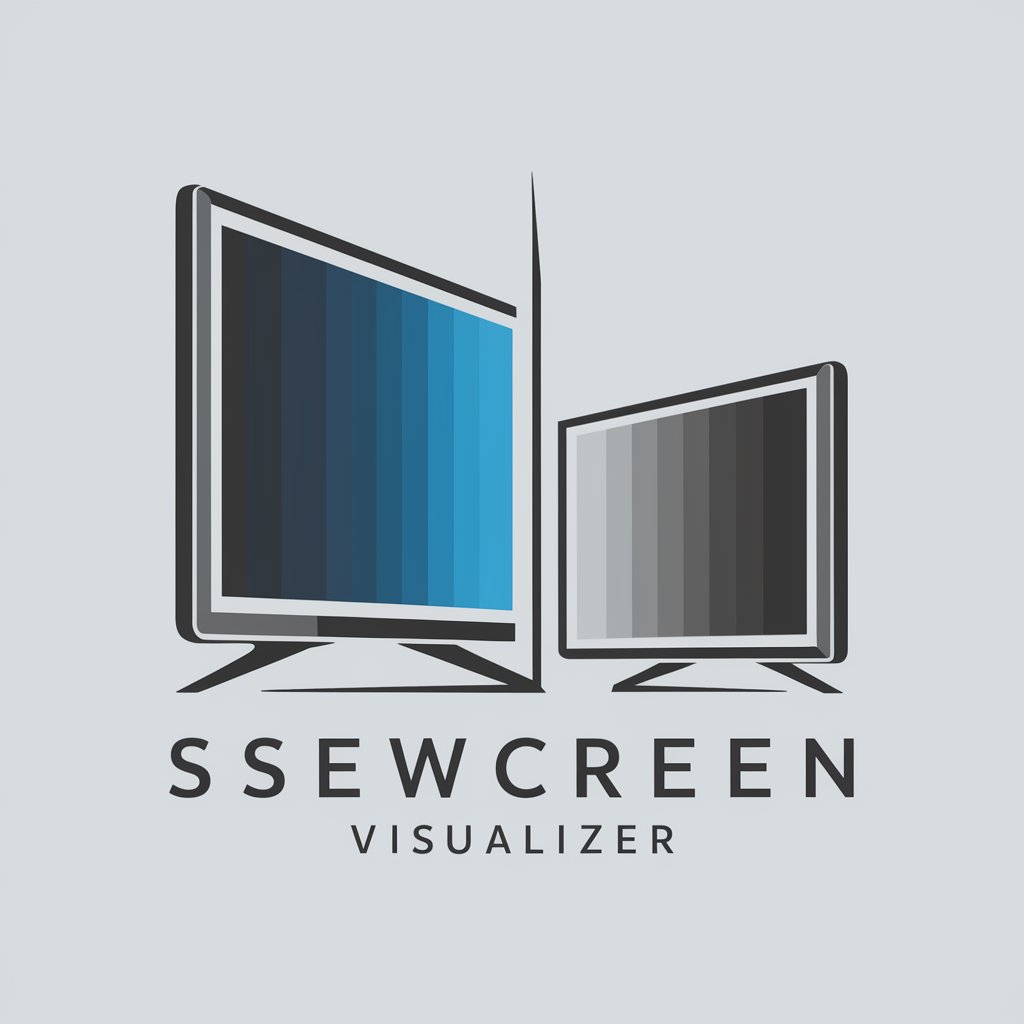Screen Visualizer - TV Screen Comparison Tool

Welcome! Ready to visualize and compare TV screens side by side?
Visualize Before You Decide
Compare a 55-inch OLED TV with a 32-inch LED TV, showing their size and display differences.
Visualize the differences between a curved TV and a flat TV, each in their respective sizes.
Show a side-by-side comparison of a wall-mounted TV versus a TV on a stand.
Illustrate the screen quality and size difference between a high-definition TV and a 4K TV.
Get Embed Code
Understanding Screen Visualizer
Screen Visualizer is designed to visually compare two television screens side by side, focusing on their differences in size, appearance, and the clarity of content displayed. Its primary purpose is to provide a realistic portrayal of television screens to aid users in making informed decisions or comparisons without the need for technical expertise. For example, a user contemplating between a 55-inch 4K television and a 65-inch OLED model could use Screen Visualizer to see a visual comparison of the two, including how text and images would appear on each screen, thus aiding in their purchasing decision. This tool is particularly useful in scenarios where visual size and quality comparison is essential, and it strives to present this information in a user-friendly and accurate manner. Powered by ChatGPT-4o。

Core Functions of Screen Visualizer
Visual Size Comparison
Example
Comparing a 32-inch HD TV to a 48-inch 4K UHD TV, showing the physical size difference and potential viewing experience.
Scenario
This function is applied when users want to understand how different screen sizes would fit within their space, such as a living room or bedroom, providing a visual sense of scale and impact.
Display Clarity Representation
Example
Demonstrating how a Full HD screen compares to a 4K screen in terms of clarity and detail, especially for text and high-definition images.
Scenario
Useful for users trying to discern the benefits of higher resolution screens for gaming, movies, or professional work that requires fine detail.
Appearance and Design Visualization
Example
Showing the aesthetic differences between two models, such as a traditional flat screen versus a curved screen, including bezel size and stand design.
Scenario
Helpful for users who are considering how a TV's design will complement their home decor and setup aesthetics.
Who Benefits from Screen Visualizer?
Home Entertainment Enthusiasts
Individuals looking to upgrade their home theater setup and wanting to compare different television models to find the perfect fit for their viewing needs.
Professional AV Setup Planners
Professionals who design audiovisual setups for venues, offices, or public spaces and need to visualize how different screens will look in a specific environment.
Retail Consumers
Shoppers in the market for a new TV who wish to make a more informed purchase by comparing models based on visual size, clarity, and design.

How to Use Screen Visualizer
Start Your Trial
Visit yeschat.ai for a complimentary trial, accessible immediately without the need for a login or ChatGPT Plus subscription.
Choose Your Comparison
Select the 'Screen Visualizer' option and input the specifications for the two TV screens you wish to compare, including size, resolution, and model.
Customize Content
Upload or choose the content (images, text, or video clips) you want displayed on each TV screen for a realistic comparison.
Visualize and Adjust
Use the visualization tools to adjust the viewing angles and environment settings to match your actual viewing conditions.
Analyze and Decide
Examine the detailed comparison to understand the differences in display quality, size, and clarity, aiding in your purchase or analysis decision.
Try other advanced and practical GPTs
Screen Sage
Discover movies with AI brilliance

DM Screen
Enhance Your D&D Experience with AI

Marvin
Your nerdy, snarky AI sidekick.

Marvin
AI-powered pessimistic assistant

Martin
Elevate your data analysis with AI

Marvin
Learn anatomy with a smile.

Screen Artist
Turn imagination into OLED art.

Infection Control Mentor
Empowering infection control with AI

Infection Control Expert
Empowering Infection Control with AI

Diabetes Injection Buddy
Smart management for your insulin therapy.

Infection Control Companion
Empowering infection prevention with AI

SQL Injection Demonstrator
Master SQL Injection Safely with AI

FAQs About Screen Visualizer
What makes Screen Visualizer unique compared to other comparison tools?
Screen Visualizer offers a real-time, AI-powered visualization of two different TV screens side-by-side with customizable content, enabling users to make informed decisions based on realistic comparisons rather than just specs on paper.
Can I compare screens of vastly different sizes and resolutions?
Absolutely, Screen Visualizer is designed to handle comparisons across a wide range of sizes and resolutions, presenting them in a manner that accurately reflects real-life differences.
Is it possible to visualize how specific content will look on my TV?
Yes, you can upload or select specific content to display on the screens within the visualization, allowing you to see exactly how text, images, or videos will appear on each model.
How can Screen Visualizer help in an academic setting?
For academic purposes, Screen Visualizer can be used to study the impact of display technologies on viewer perception, conduct comparative research on screen clarity and color accuracy, or as a teaching aid in media studies.
Does Screen Visualizer support comparison of outdoor viewability?
Yes, the tool includes settings to adjust for environmental conditions, such as lighting and background, to simulate how each screen performs outdoors or in well-lit areas.
